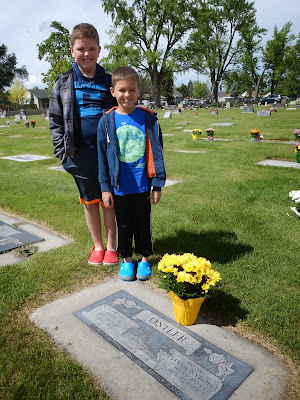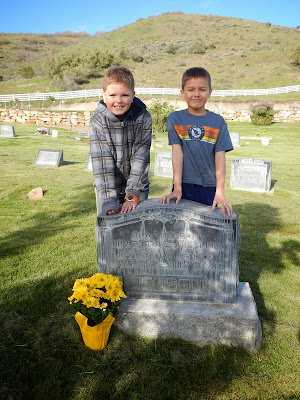Amy Emily Downs was born January 25, 1823 in Crawford County, Indiana, daughter of Ezekiel Downs and Charlotte Rawlings. Her great grandfather Zacharia Downs, emigrated from
Scotland to North Carolina before the War of Independence. Being an elderly man, owning a grist mill, he was exempted from service. Her grandfather, Thomas Downs, enlisted in his seventeenth year and served during the war, and marched in the hot sand until his feet bled. He dipped the water in his hat as he marched along to give it to the wounded soldiers. He enlisted under General McDonald and fought under George Washington.
Her father had an even temper, rather on the extreme both ways. Her mother was even tempered, kind, and affectionate. They were well respected by their neighbors. They labored hard and made a good living.
Her family emigrated to Illinois in the fall of 1828. They located twelve miles below Quincy, a very beautiful country. The land was very rich, the prairies interspersed with beautiful groves of timber, with singing birds, and the country abounded with wild game, fish and wild fruit and honey. Her father bought calves and raised them for the market. He bought land and fenced 160 acres. He broke 100 acres and raised large crops of corn, wheat, oats and beans, potatoes, pumpkin, melons, and raised hogs for the market.
In the spring of 1839, the members of the Church of Jesus Christ of Latter Day Saints were driven from Missouri and the main body crossed at Quincy and some at Hannibal. Five came to their place with one old wagon and a poor span of horses, and they looked upon them as poor persecuted people, and they took them in and gave them work and helped to feed and clothe them. The family began to predict that her oldest brother James would be a Mormon, and he laughed at the idea. But when he heard the Elders set forth the first principles of the Gospel, he received it with joy and he was the first one of the family to be baptized on October of 1840 by Bishop David Evans. He had manifestations of the truth to what he received from time to time.
Elder Hyde was sent from Nauvoo to counsel her family to trade farms with the anti-Mormans in Hancock County and they moved and settled in Knowltons Settlement, 13 miles below Nauvoo. Soon after her brother joined the church, her father, mother, and two sisters were baptized. She was a member of the church when on November 5, 1840 she married Absolom W. Smith, who was born June 22, 1819 at Clarksburg, Harrison County, West Virginia.
In the month of June 1844, her brother James had been down to his father’s. As he was returning home, he saw a body of armed men in a little town called Loina, and he supposed it was training day, but was soon informed that it was a mob gathered to make an attack on Father Morley’s settlement that night. The settlement was about three miles distant. But before he reached the settlement that night, he saw a black cloud rising in the northwest. He increased his speed and reached a house just as the storm set in. It blew down fences, uprooted trees, and the rain fell in torrents. The next morning the roads were so filled with timber he had to pick his way through the woods. Her brother mentions this to show that the Lord chose the storm to save his people, for the mob had laid plans to make an attack on all the settlements, as well as Nauvoo.
Her family was living near Nauvoo at the time of the martyrdom of the Prophet Joseph Smith, her brother said he could not describe the scene that followed the slaughter at Carthage. He said the heavens seemed to weep over the horrible deed as it rained so much, and all Nauvoo seemed to wear a gloom.
In the spring of 1845 her father traded farms with Eli Walker four miles east of Nauvoo. He went up and put in a crop and in the summer, the mob began to howl and wagon load of armed men passed her father’s door and fired their guns and yelled like demons.
Early in the fall old Col. Williams, a Baptist preacher, raised sixty men and camped in the woods two miles from her father’s place, and commenced burning houses. He sent twelve well armed men with orders to the Mormons to take their sick folks and leave. They did so and let them burn their homes. My father’s was a frame building, painted and done up in good shape with four good rooms and cost about $800.00. Her father sold his farm for $1153.00 which was less than half it was worth, and was glad to get that to get an outfit to leave for the west.
Her husband was baptized into the Church of Jesus Christ in August of 1843, by Elder Isaac M. Stewart in Adams County, Illinois. The fall she was married she and her husband went to West Virginia and spent the winter. This was her husband’s home as a boy. Her husband left West Virginia when he was a boy of seventeen with his sister and husband, a Mr. Shinn. They came to Quincy, Illinois April 22, 1838. He went to Mr. Shinn’s father’s home, stayed over night and then went to Payson 16 miles south of Quincy where he expected to make his future home. Here he leased 50 acres of land from David Shinn, and in the winter and spring of 1838 and 1839 he had it fenced and commenced breaking the ground. By June he had it ready for corn and in the spring of 1840 he put in a good crop and harvested about four hundred bushels of wheat and a good crop of corn. He was then about twenty-one and that was the last year of his lease. He thought for some time he should have a companion, and he had become acquainted with Amy Emily Downs, so that fall they were married.
In the spring of 1846, she with her husband, father, mother, two brothers, and two sisters started with the main body of the church and all stopped at Council Bluffs for the winter. Here she and her husband remained until the spring of 1852 when they started for Utah. They crossed the plains in Isaac M. Stewart Company and settled at Willow Creek, now Draper. She drove a span of oxen all the way across the plains. They had two children born in Illinois and two after they left Nauvoo. She had six more in Utah, which made ten in all.
Melissa Ann Smith was a middle child born in Draper. She later married Manassah Fitzgerald and had a daughter whom she named Melissa Ann (wearing the hat) who became my husband Glen's maternal great grandmother.
She was a very devoted mother. She told her children she had crossed the plains and gave up her home in the east that they may enjoy the blessings of the true Gospel.
She was a talented woman and very accomplished in sewing, and her talent was handed down to her daughters, and many of her granddaughters. One of the daughters of the second wife tells that when times were hard and there was no money to buy things, she always had gifts made to surprise the children for Christmas. The family lived on the main highway, seventeen miles south of Salt Lake City, so they entertained many of the leaders of the Church as they traveled from Salt Lake City. She washed, corded, and spun many pounds of wool to provide clothes for the family.
She was an active member in the Relief Society for many years. She died August 26, 1896 in Draper, Utah.






























































